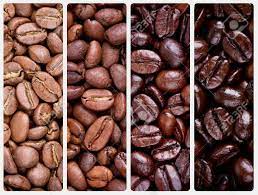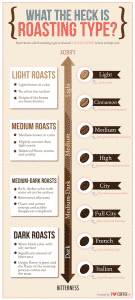- January 5, 2022
A Guide to Coffee Roasts

Greetings!
Ever wonder what coffee roasts really mean? What is the difference between light roast and dark roast? Does the amount of caffeine differ? Do they taste differently? How do I know what is the best roast for me?
Don’t worry, we have done the painstaking research and present to you, A Guide to Coffee Roasts:)

Coffee Roasting Basics
First, some straight basics: what is coffee roasting? Coffee beans are the green, grassy seed inside a coffee cherry. Coffee is stored in this green state as it won’t lose flavor or quality. Green coffee beans are shipped and stored until it’s time to roast and enjoy. Coffee roasting is the process of heating the green coffee beans into the toasty, rich, aromatic beans of magic we all know and love. Roasting rapidly heats the beans at high temperatures causing chemical and physical changes in coffee beans. Once the optimal heat is reached, the beans are cooled to stop the roasting process. At this point they are ready to be ground, brewed and enjoyed. The science of coffee roasting is highly technical and intuitive. Roasters often make decisions with split second precision. Tweaking the temperature just a few degrees can make a world of difference.
Know Your Coffee Roasts
While there are no over arching coffee roasting standards, there are accepted practices and four general roast types; light, medium, medium-dark and dark. Fun fact* many consumers assume that the darker the roast, the higher the caffeine, but often light roasts contain the highest caffeine concentration because the longer and hotter a coffee bean is roasted the further the caffeine is roasted out it. Understanding the general principles of each roast will help you make the best decision for which coffee roast is right for you.
The spectrum of light to dark roast is a journey from acidic to bitter with many nuances along the way. Know that each roaster will have their own interpretation of each roast type, but the generalities outlined below will help guide your decision.

A Guide to Coffee Roasts
Light Roasts
Visually light roast coffees are, you guessed it, the lightest brown in color, but they also have no oil on the beans because they are not roasted long enough for the oil to break through the bean. The light roasts are light color as well as light in viscosity or body. Roasted until the ‘first crack’, light roasts get toasted between 350 degrees and 410 degrees. Light roasts are very popular with single origin, small batch roasters because the tasting notes specific to each origin are highlighted. Proponents of light roasts believe the dynamism of each unique note can be masked in darker roasts.
- Common Names: Light City, Half City or Cinnamon.
Medium and Medium-Dark Roasts
Far and away the most popular roast in the United States, the medium roast is slightly darker and still has no oil on the beans. Medium roasts loose a bit of the floral notes that light roast fanatics adore, but gain a bit of body and robustness that have garnered them fan favorite. Roasted until just before the ‘second crack’, which is generally between 410 degrees and 440 degrees. Medium roasts are often lauded for their richness and bittersweet after taste.
- Common Names: Breakfast, American or Full City
Dark Roasts
Dark roasts are the oily beans you may have seen and wondered why they look shiny. These dark coffees are roasted at the highest temperature, above 440 degrees so the naturally occurring oils in the beans break through and are present at the finish. They get their depth of flavor from that oil that has burst out during the roasting process. Dark roasts have the strongest, most robust flavor and often have a strong bitterness. The darker the roast, the less acidity will be present.
- Common Names: French, Italian, Espresso, Continental, European, Viennese, High and New Orleans.
Deciding on Your Perfect Roast
With this Guide to Coffee Roasts, it’s time to get out there, brew some coffee and decide-if you haven’t already!- which coffee roast is right for you. Our favorite method is to taste, taste, taste. It is very fun and informative to do a side by side taste test. If you have more than one coffee brewing implement at home, I recommend a light roast in a pour over or french press, a medium in a french press and a dark roast in a moka pot or machine and see what you think! I like them all and enjoy different roasts at different times (linked a few favs in case you’re in the market). For me, a bright floral light roast is perfect in warmer weather, they feel like sunshine to me. When it’s cold and snowy, I love a deep rich dark roast to get me cranking when it’s still dark and I want to start my day. When I try a new producer partner, I like to test the quality with a lighter roast to pick up as much of the terroir, or area specific flavor, as possible. We find that Kebon customers dig on medium roasts the most.
Let us know what you think! What are your favorite coffee roasts? Do you try different roast levels at different times of the year? Different times of the day? Fill us in!
Happy Brewing,
~Winter
winter@kebon.co